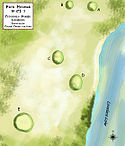
The Troyville culture is an archaeological culture in areas of Louisiana and Arkansas in the Lower Mississippi valley in the Southeastern Woodlands. It was a Baytown Period culture [1] and lasted from 400 to 700 CE during the Late Woodland period. It was contemporaneous with the Coastal Troyville and Baytown cultures (all three had evolved from the Marksville Hopewellian peoples) and was succeeded by the Coles Creek culture. [1] Where the Baytown peoples built dispersed settlements, the Troyville people instead continued building major earthwork centers. [2] [3]




